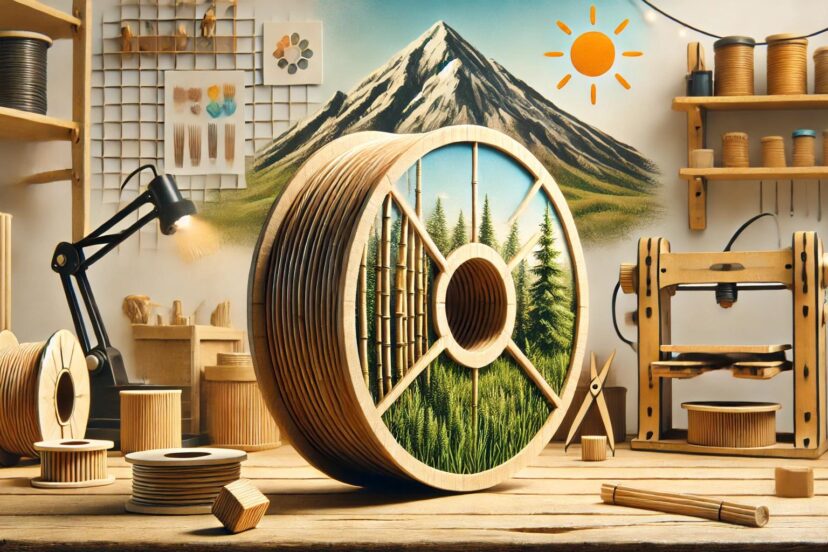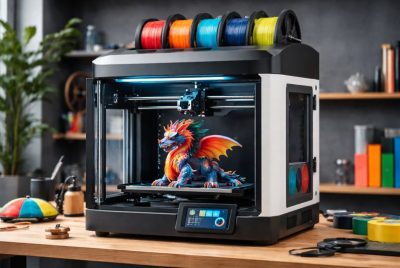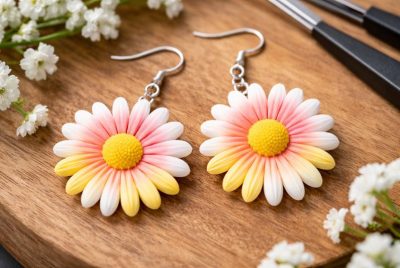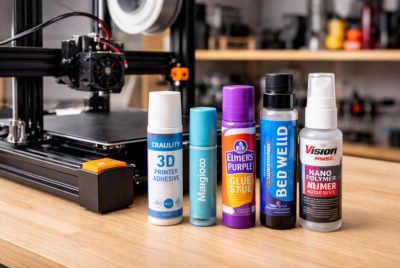Bamboo 3D Printer: Revolutionizing Sustainable Manufacturing
Hey there, listen up! Imagine a world where everything we use in our daily lives is eco-friendly and sustainable… Looks nice, isn’t it? But the question is… is that possible? Yes! Let me introduce you to the magic of the bamboo 3D printer. The word Bamboo itself feels eco-friendly already! In this article, we’ll dive into the world of bamboo 3D printers. Learn everything about their perks, uses, and why they’re the future of green technology. Let’s get this started!
What is a Bamboo 3D Printer?
First time hearing about a bamboo 3D printer? Yep, I’m not joking. It’s a thing and you heard it right. This isn’t your ordinary 3D printer that churns out plastic gizmos. A bamboo 3D printer, as the name already states, uses “bamboo-based filaments” to create objects. It’s a great option for an eco-friendly alternative. Renewable and biodegradable at the same time 😉
Why Bamboo?
So you’re asking… why should we even consider bamboo as a 3D printer? Alright folks, as a beginner, bamboo grows faster than you… I mean faster than you can say “sustainability”. Bamboos are known for being super durable and flexible. Plus, they look stunning!!! Using bamboo helps us kick our nasty plastic habit and give Mother Earth a well-deserved break. For me, I’d love to help the environment and reduce pollution in my own little way. You should too!
The Basics of 3D Printing
First things first, here’s a little 3D printing 101 for you. What in the world is 3D printing? It’s additive manufacturing which in simple words, is a process of creating three-dimensional objects from a file. It works like magic! From a digital blueprint, it creates 3D objects layer by layer. This tech is shaking up everything from hobbyists to home users like you and me!
Benefits of Bamboo 3D Printers
1. Eco-Friendly: Bamboo is Mother Nature-approved. You’re literally saving the environment by using this!
2. Sustainable: Bamboo grows super fast like a weed, without harmful side effects.
3. Aesthetic Appeal: It’s stunning and has a natural charm that no plastic can ever mimic.
4. Durability: Bamboo filaments are strong and flexible.
Applications of Bamboo 3D Printers
1. Eco-Friendly Packaging: Imagine unboxing your next gadget in eco-friendly, bamboo-based packaging.
2. Home Décor: From chic picture frames to adorable plant holders, bamboo 3D printers can craft some cool home accessories.
3. Prototyping: Perfect for creating sustainable prototypes in product development, with nature’s touch!
4. Educational Tools: Using 3D printers is a chance to teach kids about a technology that is sustainable and biodegradable.

Getting Started with a Bamboo 3D Printer
1. Choose the Right Printer: Important note!! Not all printers can handle bamboo filaments so be careful and make sure yours can.
2. Select Quality Filament: Always choose the best filament quality.
3. Calibrate Your Printer: Remember, proper calibration is key. It’s like tuning your favorite guitar so it sounds nice.
4. Start with Simple Projects: Don’t push yourself and your printer too hard. Try simple, basic designs to get used to bamboo filament.
Printing Tips for Bamboo Filament
1. Temperature Settings: Bamboo filament likes it hot. But always check those manufacturer guidelines first.
2. Bed Adhesion: Use a heated bed and maybe a little adhesive to keep things from warping.
3. Print Speed: If you’re a beginner, start slow, please. Slow and steady wins the race with bamboo filament.
4. Storage: Store your bamboo filament in a cool, dry place. Moisture can mess with your filaments.
Common Challenges and Solutions
1. Clogging: Bamboo filaments can sometimes clog nozzles. I know it’s kinda annoying. So regular maintenance is your best friend here guys.
2. Warping: Warping and twisting can be a pain. As a quick fix, try to adjust the bed temperature and use some adhesive.
3. Stringing: If your filament starts to drag, that’s fine… It’s normal! Just tweak the retraction settings then you’re good.
The Future of Bamboo 3D Printing
I believe that there’s a bright future for bamboo 3D printing. Nowadays, more people (like you and me) are becoming more “eco-conscious”, and the demand for sustainable manufacturing solutions will skyrocket in no time. Innovations in filament technology and printer capabilities will only make bamboo 3D printers even cooler. I’m excited to discover more products or techs that are made from natural, sustainable materials. Goodbye to harmful plastics and say hello to loving Mother Earth!
The book “Advances in Sustainable Manufacturing”, edited by G. Seliger, M. M. Zarte, and S. Wenzel, and published in the Springer Series in Advanced Manufacturing in 2017, provides a comprehensive overview of the latest advances in sustainable manufacturing technologies and practices. It includes case studies and examples from various industries, highlighting the benefits and challenges of implementing sustainable manufacturing. Complementing this, the paper “Metrics and Tools for Sustainable Manufacturing” by S. Kara, S. Ibbotson, and M. Z. Hauschild, published in the CIRP Annals in 2018, reviews the metrics and tools used to assess and improve the sustainability of manufacturing processes. This paper discusses life cycle assessment (LCA), material flow analysis (MFA), and other methodologies for evaluating environmental, economic, and social impacts, thereby providing a framework for implementing the practices outlined in the book.
Comparing Bamboo Filament to Other Filaments
1. PLA: PLA is eco-friendly but lacks bamboo’s natural flair.
2. ABS: ABS is tough but not biodegradable. Bamboo takes the green crown.
3. PETG: PETG is strong and flexible, but bamboo stands out with its sustainability.
Products to Consider
- Bamboo Filament Spools – High-quality bamboo filament for 3D printing, compatible with most 3D printers.
- 3D Printing Pen Filament – Eco-friendly bamboo filament designed for use with 3D printing pens.
- Wood Filament Bundle – A pack of wood filaments allows users to test different types before committing to a larger purchase.
- Bamboo Filament Storage Box – Airtight storage containers to keep bamboo filaments dry and free from moisture.
- Bamboo 3D Printed Plant Pots – Ready-made plant pots created from bamboo filament, perfect for eco-friendly home décor.
Maintaining Your Bamboo 3D Printer
1. Regular Cleaning: Always keep the nozzle and print bed clean for smooth sailing and printing.
2. Lubrication: Apply lubricant to the moving parts to keep things running smoothly and avoid warping.
3. Software Updates: Keep your printer’s software up-to-date (if there’s any) to ensure it’s always in tip-top shape.
DIY Projects with Bamboo 3D Printers
1. Custom Coasters: Create unique, biodegradable coasters for your home. It can be a nice gift to your loved ones!
2. Plant Pots: Design and print beautiful plant pots that are eco-friendly. Maybe your mom will like this?
3. Jewelry: If you’re feeling extra, craft one-of-a-kind bamboo jewelry pieces that make a statement.
The Cost of Bamboo 3D Printing
Sure, bamboo filament might cost a bit more than plastic, but the environmental benefits? Man, they are worth it. Plus, as this technology becomes more mainstream, prices are likely to drop. Give it time and you’ll see how fast they’ll grow and beat the competition.
Conclusion
Bamboo 3D printers are the future of additive manufacturing. They’re eco-friendly, and sustainable making them a perfect choice for anyone who wants to help reduce pollution and care for the environment we live in. You can do lots of things with the Bamboo 3D printer… from home décor to DIY crafts, the possibilities are endless. Let’s embrace the future of green technology with bamboo 3D printing and do what we can to help Mother Earth.
FAQs about Bamboo 3D Printers
1. What is a bamboo 3D printer?
A bamboo 3D printer uses bamboo-based filaments to create objects, offering an eco-friendly alternative to traditional plastic filaments.
2. Why is bamboo considered sustainable?
Bamboo grows quickly, can be harvested without harming the environment, and is biodegradable, making it a highly sustainable resource.
3. Can any 3D printer use bamboo filament?
Not all 3D printers are compatible with bamboo filament. It’s essential to check the printer’s specifications and ensure it can handle the filament type.
4. What are some common challenges with bamboo 3D printing?
Common challenges include clogging, warping, and stringing. Proper printer maintenance and adjustments can help mitigate these issues.
5. What are the main benefits of using bamboo 3D printers?
Bamboo 3D printers are eco-friendly, sustainable, and durable, and provide a unique natural aesthetic to printed objects.




